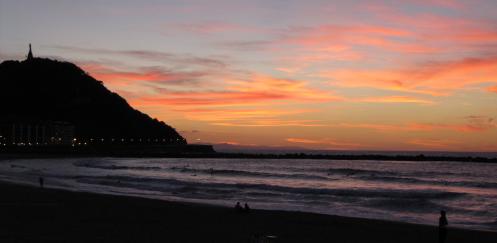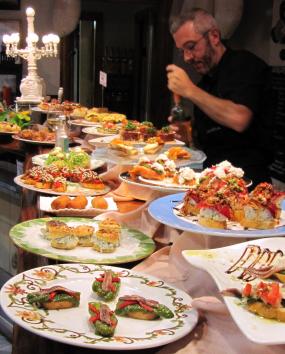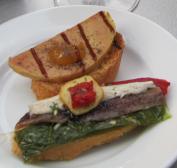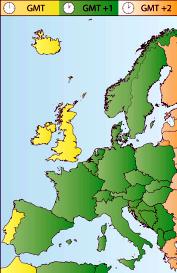
Margie and I usually vacation in Europe at least once a year. I speak French, Italian, and Spanish, and one purpose of these trips is to try to maintain my facility with these languages. With languages, it's "use it or lose it", but the United States, where we live, is a country 5,000 Km wide in which one seldom hears any language other than English. So travel to France, Italy, and Spain gives me a chance to practice using one of these tongues. But we've usually, in fact, alternated in our travel between France and Italy, very seldom visiting Spain. One reason is that of all foreign languages, Spanish is the easiest one to use within the United States. According to Wikipedia, in the United States, "34 million people, 12.2 percent of the population more than five years old, speak Spanish at home." Note 2 Thus, Spanish could be called the second language of the United States. Another reason we travel less to Spain is that it's easier to visit Spanish-speaking countries right here in the western hemisphere. It's a short hop to Mexico and the countries of Central America, and Spanish is the language of all the countries of South America, with the very large exception of Brazil. But there's a third reason we don't travel to Spain: we find it hard to eat there. Spain has what is, for us, a very odd dining schedule. People often don't have dinner until 10:00 in the evening, and after a busy and active day as tourists, we simply can't stay up that late. Ending our meal at 11:00, and then staying up until 12:00 or 1:00 so as not to go to bed on a full stomach, is just too late. Why do the Spanish dine so late? One reason is that, with warm Atlantic currents to its west, and the Mediterranean Sea to its east, Spain is, for much of the year, a rather warm country. Its people thus developed a pattern of taking a "siesta" during the heat of the early afternoon, and then waking up to a period of work that lasted into the cool of the evening. Stores and businesses often close at 2:00 P.M. for lunch and a siesta, and then re-open at 5:00 P.M., staying open until 9:00 in the evening. Restaurants seldom open for dinner before 9:30. Late dinners are the custom in Italy as well. But in Italy, restaurants open earlier. I've often had the experience in Italy of telephoning for a dinner reservation, and being told that no reservations are available that evening. "Wait", I'll say, "don't hang up. We're American tourists - how early do you open for dinner?" We then reserve a table at 7:30. As we're finishing our dinner at 9:00 or 9:30, other diners are starting to trickle in.
We ate a lot of tapas in Spain, and they are delightful. But still, we don't find it good to make a dinner out of these night after night. Our long days of tourist activities are often spent on our feet, either walking around historic villages, or in museums. What we want to do for dinner, above all, is to sit down and be served a leisurely meal! Tapas are eaten mostly standing. If you do find a table, you often sit only briefly, before moving on to another bar to find greater variety. We find the inability to get a real sit-down dinner before around 9:30 detracts from our enjoyment of Spain.  One evening, late in our week in San Sebastián, I sat on our apartment balcony watching the sunset pictured above, and I thought to myself that even the sun participates in Spain's late schedule - the sunset was at about 8:30 P.M. Then I realized that I must have had cause and effect reversed. Obviously, the times of sunrise and sunset must be one of the causes, and not an effect, of the late Spanish schedule. But why was the sun setting so late? It was September, only about a week before the autumnal equinox, when day and night are the same length, 12 hours each. So sunrise and sunset ought to be halfway between noon and midnight - that is, at about 6:00 A.M. and 6:00 P.M. Why was I seeing a sunset at around 8:30? In the middle of summer, perhaps, when the days are long, but near the equinox? I thought about it some more. Well, one factor is what we in the United States call "Daylight Savings Time", and which the British call "Summer Time". The time being used in Spain in September is abbreviated "C.E.S.T.", which stands for "Central European Summer Time". That accounts for one hour of the difference. Without that "spring forward" adjustment, sunset would have been around 7:30.
So what could be the solution to our dilemma of the late dinners in Spain? I said above that as tourists, we would have a hard time dining at 10:00, and going to bed at 1:00 A.M. But why should I have a hard time with that? It's all in my head; it's the "tyranny of the clock". Suppose I just defined "LSST", "Larry's Spanish Summer Time", as being two hours earlier than the actual clock setting in Spain (thus it would be GMT-1). I would have lunch at 12:30 LSST, eat dinner at 7:30 LSST, and go to bed at 11:00 LSST. Eight hours of sleep would have me waking at 7:00 LSST. These all seem like reasonable times to me, and I don't see why I should have any trouble with them. The schedule is close to that which I keep at home, except we usually eat dinner at more like 6:30. Of course, by a Spanish clock, the times would read as follows: sleep until 9:00, have lunch at 2:30, dinner at 9:30, and bedtime at 1:00 A.M. And bingo - I'm on the Spanish schedule. So it's all in our heads! Truly, as my subtitle reads, "The pain in Spain is mainly in the brain". In fact, "LSST" would be easier to adjust to than the CEST that Spain actually uses. After all, my "LSST" represents only a four-hour shift from Boston's EDT ("Eastern Daylight Time"), rather than the six-hour shift of CEST. It costs me less "jet lag" to put myself onto LSST (which is the de-facto Spanish schedule) than to try to impose my home eating schedule onto a Spanish clock! Note 4 I imagine that in prehistory, mankind had a very approximate notion of time, watching the sun make its way across the sky during the course of a day. But now, we watch our clocks very closely. We arrange meetings at specific times, and are annoyed at those who show up five minutes late. Five minutes is less than a third of one percent of a full day. I've always been surprised at how easy it often is in the US to get into what will be a crowded lunch place just by arriving a few minutes before noon. Why don't more people realize that they could make their lives much easier by just leaving for lunch a few minutes early? They could make up for it by returning that same few minutes before one. The clock is of our own making. We should rule it, not the other way around.   Note 1: The tapas pictures in this entry were all photographed at the bar "Bergara", in San Sebastián, Spain. [return to text] Note 2: http://en.wikipedia.org/wiki/Spanish_language [return to text] Note 3: This map is taken from a photo download of the European Commission. [return to text] Note 4: That my sunrise-sunset times are approximate is partly accounted for by the earth's tilt, and the earth's elliptical orbit. These produce the well-known "analemma", a figure that describes the east-west deviation of the sun from due south at clock noon. This is described in great detail by a marvelous web site that can be found at http://www.analemma.com/. This site makes very effective use of Flash animations to clarify an otherwise highly mathematical subject. [return to text]  |

 But in Spain, for the most part, you simply can't have a sit-down-and-be-served dinner at 7:30. What you can have are "tapas", small bite-sized snacks that are widely available starting in the late afternoon. On our vacation in September of 2010, we spent a week in what might be described as the tapas capital of Spain, San Sebastián, in the Basque country, a region that probably has the greatest variety of tapas in all of Spain. There, these delightful treats are called "pintxos" (pronounced "PEEN-choss", with a long "o" to rhyme with "dose"). In a tradition called "txikiteo", people go from bar to bar and have a few of these, and a small glass of wine, or a small glass of beer called a "zurito" (a large beer is a "caña"). When you leave, you need to tell the man at the bar what you ate so he can total the bill. Itís a grave sin to not list everything you had. I'm told that in some bars in Spain, each tapa comes with a toothpick through it, and the bill is added up by counting the toothpicks. But that system was not generally used in San Sebastián.
But in Spain, for the most part, you simply can't have a sit-down-and-be-served dinner at 7:30. What you can have are "tapas", small bite-sized snacks that are widely available starting in the late afternoon. On our vacation in September of 2010, we spent a week in what might be described as the tapas capital of Spain, San Sebastián, in the Basque country, a region that probably has the greatest variety of tapas in all of Spain. There, these delightful treats are called "pintxos" (pronounced "PEEN-choss", with a long "o" to rhyme with "dose"). In a tradition called "txikiteo", people go from bar to bar and have a few of these, and a small glass of wine, or a small glass of beer called a "zurito" (a large beer is a "caña"). When you leave, you need to tell the man at the bar what you ate so he can total the bill. Itís a grave sin to not list everything you had. I'm told that in some bars in Spain, each tapa comes with a toothpick through it, and the bill is added up by counting the toothpicks. But that system was not generally used in San Sebastián.
 Another major factor is the longitude of Spain. Nearly all of Spain, with the exception of Cataluña (the extreme eastern tip), is west of the Greenwich meridian (the "prime" meridian, zero degrees longitude). So based on its longitude, Spain ought to be in the same time zone as England, Greenwich Mean Time ("GMT"). After all, it's south and mostly to the west of England.
Another major factor is the longitude of Spain. Nearly all of Spain, with the exception of Cataluña (the extreme eastern tip), is west of the Greenwich meridian (the "prime" meridian, zero degrees longitude). So based on its longitude, Spain ought to be in the same time zone as England, Greenwich Mean Time ("GMT"). After all, it's south and mostly to the west of England.